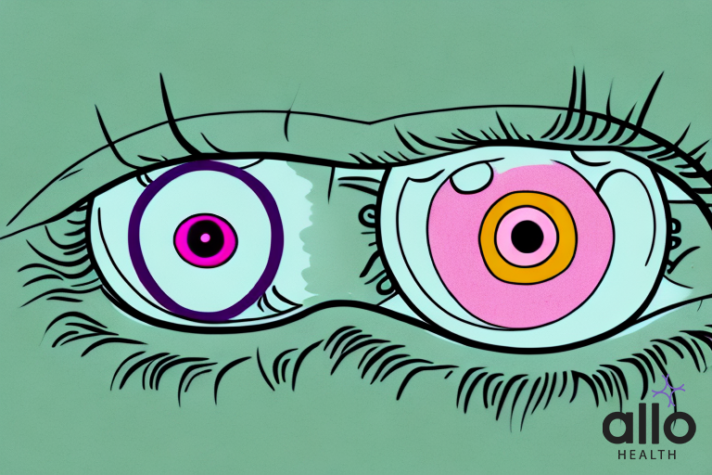Comparing Chlamydia and Gonorrhea Conjunctivitis

"The following blog article provides general information and insights on various topics. However, it is important to note that the information presented is not intended as professional advice in any specific field or area. The content of this blog is for general educational and informational purposes only.
Book consultation
The content should not be interpreted as endorsement, recommendation, or guarantee of any product, service, or information mentioned. Readers are solely responsible for the decisions and actions they take based on the information provided in this blog. It is essential to exercise individual judgment, critical thinking, and personal responsibility when applying or implementing any information or suggestions discussed in the blog."
Sexually transmitted infections (STIs) are a widespread health issue worldwide, with millions of people affected every year. Among the different types of STIs, Chlamydia and Gonorrhea are the most common bacterial infections. They can infect the genitals, rectum, and throat, but they can also cause conjunctivitis, a contagious eye infection that affects the conjunctiva, the membrane lining the eyelids and the surface of the eye. In this article, we will provide an in-depth comparison of Chlamydia and Gonorrhea conjunctivitis, including their causes, symptoms, diagnosis, treatment, and prevention strategies.
An Overview of Conjunctivitis
Conjunctivitis, also known as ‘pink eye’, is a common eye infection that affects people of all ages. It is an inflammation of the conjunctiva, the thin membrane that covers the white part of the eye and the inner surface of the eyelids. Conjunctivitis can be caused by different factors such as allergies, viruses, bacteria, or irritants. The symptoms of conjunctivitis vary depending on the cause, but they usually include redness, itchiness, tearing, discharge, and discomfort.
It is important to seek medical attention if you suspect you have conjunctivitis, as some types of the infection can be highly contagious and may require prescription medication to treat. Additionally, practicing good hygiene, such as washing your hands frequently and avoiding touching your eyes, can help prevent the spread of conjunctivitis. If you wear contact lenses, it is recommended to avoid wearing them until the infection has cleared up to prevent further irritation and potential complications.
Causes and Symptoms of Chlamydia Conjunctivitis
Chlamydia trachomatis is a bacterium that can cause a wide range of infections, including conjunctivitis. Chlamydia conjunctivitis is usually caused by direct contact with infected genital secretions, which can occur during unprotected oral sex or by touching the eyes after touching the genitals. The symptoms of Chlamydia conjunctivitis usually manifest after a few days of exposure and can include redness, swelling, itching, discharge, and sensitivity to light. Some patients may also experience fever, sore throat, and lymphadenopathy.
It is important to note that Chlamydia conjunctivitis can also be transmitted through contaminated towels, eye makeup, and other personal items. Therefore, it is crucial to practice good hygiene and avoid sharing personal items with others. Additionally, individuals who are sexually active should get tested regularly for Chlamydia and other sexually transmitted infections to prevent the spread of the disease.
If left untreated, Chlamydia conjunctivitis can lead to serious complications such as corneal scarring, vision loss, and even blindness. Therefore, it is important to seek medical attention as soon as possible if you suspect that you may have contracted the infection. Treatment typically involves a course of antibiotics, which can effectively clear the infection and prevent further complications.
Causes and Symptoms of Gonorrhea Conjunctivitis
Gonorrhea is another bacterial infection that can cause conjunctivitis. Gonorrhea conjunctivitis is usually caused by eye exposure to infected genital secretions during sexual activity, childbirth, or accidental contamination. The symptoms of Gonorrhea conjunctivitis usually appear within 2-5 days of exposure and can include redness, swelling, pain, discharge, and photophobia. Unlike Chlamydia, gonorrhea can cause a more severe form of conjunctivitis, with thicker discharge and corneal involvement that may lead to vision loss.
It is important to note that gonorrhea is a sexually transmitted infection (STI) and can be easily prevented by practicing safe sex. Using condoms during sexual activity can greatly reduce the risk of contracting gonorrhea and other STIs. Additionally, regular STI testing and treatment can help prevent the spread of gonorrhea and other infections.
If left untreated, gonorrhea can lead to serious health complications, including pelvic inflammatory disease (PID) in women and epididymitis in men. It can also increase the risk of HIV transmission. Therefore, it is important to seek medical attention if you suspect you may have gonorrhea or any other STI.
Differences between Chlamydia and Gonorrhea Conjunctivitis
Chlamydia and Gonorrhea conjunctivitis share some similarities in their symptoms and transmission mode. However, there are some differences between them that can help in their identification and treatment. For instance, Chlamydia conjunctivitis tends to have a slower onset and milder symptoms than Gonorrhea conjunctivitis. Chlamydia conjunctivitis also tends to affect both eyes, while Gonorrhea conjunctivitis is more likely to affect one eye. Additionally, the type of discharge can be different between the two infections, with Chlamydia conjunctivitis having a watery or mucous-like discharge, while Gonorrhea conjunctivitis having a more purulent and thick discharge.
Another difference between Chlamydia and Gonorrhea conjunctivitis is the age group that is most affected. Chlamydia conjunctivitis is more common in newborns and infants, while Gonorrhea conjunctivitis is more common in adults. This is because Gonorrhea is primarily a sexually transmitted infection, while Chlamydia can also be transmitted from mother to child during childbirth.
It is important to note that both Chlamydia and Gonorrhea conjunctivitis can lead to serious complications if left untreated. These complications can include corneal scarring, vision loss, and even blindness. Therefore, it is crucial to seek medical attention if you suspect that you may have either of these infections.
Incidence and Prevalence of These Conditions
Chlamydia and Gonorrhea infections are widespread worldwide, with millions of new cases diagnosed every year. According to the Centers for Disease Control and Prevention (CDC), Chlamydia is the most common bacterial STI in the United States, with over 1.7 million cases reported in 2018. Similarly, Gonorrhea is the second-most common bacterial STI, with over 583,000 cases reported in the same year. Although the incidence of Chlamydia and Gonorrhea conjunctivitis is lower than other forms of conjunctivitis, the risk of developing them is still high among sexually active individuals.
It is important to note that Chlamydia and Gonorrhea infections often go undiagnosed and untreated, which can lead to serious health complications such as infertility, pelvic inflammatory disease, and increased risk of HIV transmission. In fact, the CDC estimates that only about half of all cases of Chlamydia and Gonorrhea are reported and diagnosed each year.
Additionally, certain populations are at higher risk for these infections, including young adults, men who have sex with men, and individuals with multiple sexual partners. It is crucial for individuals in these groups to get tested regularly and practice safe sex to prevent the spread of these infections.
Risk Factors for Developing Chlamydia or Gonorrhea Conjunctivitis
As with other STIs, the risk of contracting Chlamydia or Gonorrhea conjunctivitis is higher among individuals with multiple sexual partners, unprotected sex, or a history of STIs. Other risk factors include individuals who have sex with partners who have a history of STIs, sexual activity with commercial sex workers, and lack of regular STI screening and testing. Moreover, Chlamydia and Gonorrhea conjunctivitis are more common among infants born to mothers with these infections, as they can be exposed during delivery.
It is important to note that Chlamydia and Gonorrhea conjunctivitis can also be transmitted through non-sexual means, such as sharing towels or eye makeup with an infected person. Additionally, individuals who have compromised immune systems, such as those with HIV/AIDS, are at a higher risk of developing these infections.
Prevention of Chlamydia and Gonorrhea conjunctivitis involves practicing safe sex, using condoms during sexual activity, and getting regular STI screenings. Infants born to mothers with these infections can also be treated with antibiotics to prevent the transmission of the infection during delivery. It is important to seek medical attention if you suspect you may have contracted Chlamydia or Gonorrhea conjunctivitis, as early treatment can prevent complications and further spread of the infection.
Diagnosis and Treatment Options for Chlamydia and Gonorrhea Conjunctivitis
If you experience symptoms of conjunctivitis, including redness, discharge, and itching, it’s essential to seek medical attention as soon as possible. A healthcare provider can perform a physical exam, take a sample of the eye discharge for laboratory testing, and prescribe appropriate medications. The treatment of Chlamydia or Gonorrhea conjunctivitis usually involves a course of antibiotics, such as azithromycin, doxycycline, or ceftriaxone, depending on the severity of the infection and the individual’s medical history. It is essential to complete the entire course of antibiotics, even if the symptoms improve, to prevent the recurrence of the infection.
It is important to note that Chlamydia and Gonorrhea conjunctivitis can be sexually transmitted infections (STIs). Therefore, it is crucial to inform sexual partners of the infection and encourage them to get tested and treated as well. Additionally, practicing safe sex, such as using condoms, can help prevent the spread of these infections.
In some cases, conjunctivitis may be caused by a virus rather than bacteria. In these instances, antibiotics will not be effective, and the infection will need to run its course. However, a healthcare provider may prescribe antiviral medications or recommend over-the-counter remedies, such as artificial tears or warm compresses, to alleviate symptoms and promote healing.
Potential Complications of These Conditions if Left Untreated
If left untreated, Chlamydia and Gonorrhea conjunctivitis can lead to severe complications, including vision loss, corneal scarring, and blindness. Moreover, these infections can spread to other parts of the body, such as the genitals, rectum, and throat, causing more severe infections, infertility, and chronic pain. Therefore, it’s crucial to seek prompt treatment if you suspect you have Chlamydia or Gonorrhea conjunctivitis.
Aside from the physical complications, untreated Chlamydia and Gonorrhea conjunctivitis can also have psychological effects. The stigma associated with sexually transmitted infections (STIs) can cause shame, anxiety, and depression, which can affect a person’s mental health and well-being. It’s essential to seek support from a healthcare provider or a mental health professional if you’re experiencing any emotional distress related to these conditions.
Prevention is also key in avoiding the complications of Chlamydia and Gonorrhea conjunctivitis. Practicing safe sex, such as using condoms and getting regular STI screenings, can reduce the risk of contracting and spreading these infections. Additionally, avoiding sharing personal items, such as towels or eye makeup, can also prevent the spread of these infections.
Prevention Strategies to Reduce the Risk of Contracting Conjunctivitis Caused by Chlamydia or Gonorrhea
Preventing Chlamydia or Gonorrhea conjunctivitis requires adopting healthy sexual practices and getting regular STI screenings. Using barrier methods, such as condoms or dental dams, during sexual activities, can reduce the risk of infection. Moreover, avoiding sexual activity with partners who have a history of STIs, getting vaccinated against human papillomavirus (HPV), and getting regular eye exams can help prevent Chlamydia or Gonorrhea conjunctivitis.
Another important prevention strategy is to practice good hygiene. This includes washing your hands frequently, especially before touching your eyes, and avoiding sharing personal items such as towels or eye makeup with others. Additionally, it is important to avoid touching your eyes with your hands, as this can introduce bacteria and viruses into the eye.
If you do contract Chlamydia or Gonorrhea conjunctivitis, it is important to seek treatment as soon as possible. This can help prevent the infection from spreading to other parts of the body and causing more serious health problems. Treatment typically involves antibiotics, which can be administered orally or through eye drops, depending on the severity of the infection.
How to Protect Yourself from These Infections
Protecting yourself from Chlamydia or Gonorrhea conjunctivitis requires practicing good hygiene, such as washing your hands frequently, avoiding touching your eyes, and avoiding sharing personal items, such as towels or eye makeup. It’s also essential to communicate with your sexual partners about your STI status and to use barrier methods consistently during sexual activities. However, the best way to protect yourself from STIs, including Chlamydia and Gonorrhea, is to abstain from sexual activities or limit sexual activities to a mutually monogamous relationship with an uninfected partner.
In addition to practicing good hygiene and using barrier methods during sexual activities, there are other steps you can take to protect yourself from STIs. One of the most effective ways is to get tested regularly for STIs, especially if you have multiple sexual partners or engage in high-risk sexual behaviors. Testing can help detect STIs early, allowing for prompt treatment and reducing the risk of complications.
Another important aspect of protecting yourself from STIs is to educate yourself about the risks and symptoms of different infections. This can help you make informed decisions about your sexual health and seek medical attention if necessary. Additionally, it’s important to be aware of the potential long-term consequences of untreated STIs, such as infertility, chronic pain, and increased risk of HIV transmission.
The Importance of Regular Testing for STIs in Preventing Eye Infections
Regular STI testing is crucial in preventing Chlamydia or Gonorrhea conjunctivitis, as well as other STIs. Getting tested can help detect infections early, allowing for prompt treatment and reducing the risk of complications. It’s recommended to get tested for STIs every year if you’re sexually active or have multiple sexual partners. Moreover, if you’re at high risk of STIs, such as men who have sex with men, it’s recommended to get tested more frequently, such as every 3-6 months.
Aside from preventing eye infections, regular STI testing can also help prevent the spread of STIs to sexual partners. Many STIs can be asymptomatic, meaning that a person may not show any symptoms but can still transmit the infection to others. By getting tested regularly, you can ensure that you are not unknowingly spreading STIs to others.
Additionally, regular STI testing can help reduce the stigma surrounding STIs. Many people feel ashamed or embarrassed to get tested for STIs, but it’s important to remember that STIs are common and treatable. By normalizing STI testing and encouraging others to get tested, we can reduce the stigma and promote a healthier, more informed society.
Understanding the Connection Between Sexual Health and Eye Health
Chlamydia or Gonorrhea conjunctivitis is an example of how sexual health and eye health are interlinked. These infections show that sexual health can affect other aspects of our health, such as our vision. Therefore, it’s essential to adopt healthy sexual practices, get regular STI testing, and practice good hygiene to protect our sexual and eye health.
Conjunctivitis is a common eye infection that can be caused by different factors, including Chlamydia and Gonorrhea infections. These infections share some similarities in their symptoms and transmission mode, but they also have some differences that can help in their identification and treatment. Preventing and treating Chlamydia or Gonorrhea conjunctivitis requires adopting healthy sexual practices, getting regular STI screenings, and seeking prompt medical attention if you suspect an infection. By understanding the connection between sexual health and eye health, we can protect ourselves and maintain our overall well-being.
In addition to Chlamydia and Gonorrhea, other sexually transmitted infections can also affect eye health. Herpes simplex virus (HSV) can cause a severe form of conjunctivitis called herpetic keratitis, which can lead to vision loss if left untreated. Syphilis can also cause eye problems, including uveitis and optic neuritis. Therefore, it’s crucial to practice safe sex, get tested regularly, and seek medical attention if you experience any symptoms of an STI, including eye problems.






































